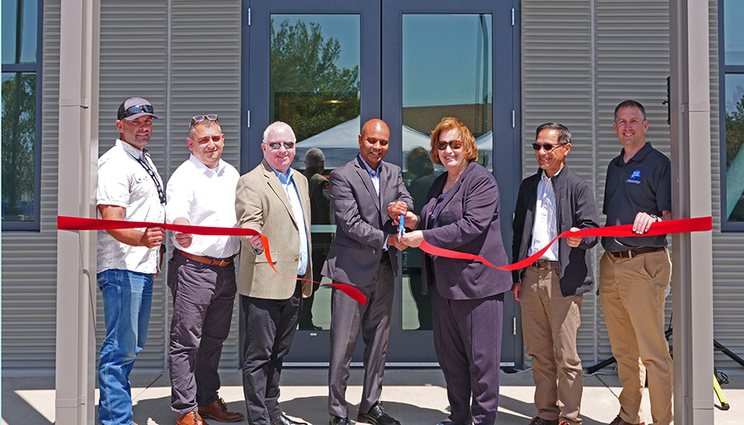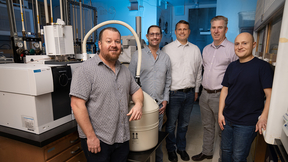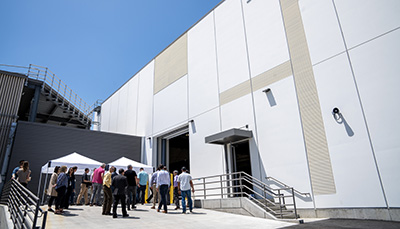LLNL introduces Advanced Characterization and Evaluation Laboratory and manufacturing facility
 (Download Image)
(Download Image)
Lawrence Livermore National Laboratory and directorate leadership on May 24 cut the ribbon on the newly-constructed Advanced Characterization and Evaluation Laboratory (Bldg. 310). Pictured (l-r): Nicholas Gomes (construction manager), Chris Spadaccini (Materials Engineering division leader), Mark Sutton (deputy associate director of Operations, Engineering), Anup Singh (principal associate director for Engineering), Pat Falcone (deputy director for Science and Technology), Tony Sy (Livermore Field Office) and Joe Tringe (Nondestructive Evaluation group leader). Photo by Lucas Tran/LLNL.
Lawrence Livermore National Laboratory (LLNL) and directorate leadership held dual ribbon-cutting ceremonies on May 24, officially marking the opening of the Lab’s Advanced Characterization and Evaluation Laboratory (ACEL) and newest advanced manufacturing facility.
The ACEL will serve LLNL’s Nondestructive Evaluation (NDE) group and the Nondestructive Characterization Institute (NCI), enabling the Lab to more rapidly mature NDE technologies that non-invasively assess properties of materials and structures, and advance characterization development. It will work in close concert with the new manufacturing facility located across the street, Building 321G, a state-of the-art, climate-controlled structure where Lab machinists and engineers will perform classified activities for the National Nuclear Security Administration’s (NNSA) stockpile modernization programs.
Engineering Principal Associate Director Anup Singh said the two facilities will add cutting-edge capabilities to the directorate as part of a broad effort to accelerate manufacturing tools and processes, produce higher quality parts and provide more comfortable working spaces to help attract the “engineering talent of the future.”
“These two buildings are part of the Lab really thinking about how we modernize our entire infrastructure, so that first we have the capability to meet the needs, not just of today, but of tomorrow, in keeping the country safe,” Singh said. “It’s also about having those people enjoy working in those facilities, because without them, you can't keep the commitment we have made to the country.”
The facilities were co-sponsored by the Lab’s Weapons and Complex Integration and Engineering directorates and NNSA, through the Livermore Field Office, with planning support by LLNL’s Project Management Office.
At the ribbon-cutting for ACEL, LLNL’s Deputy Director for Science and Technology Pat Falcone said the facility will serve as a “flexible workspace focused on collaboration” for LLNL staff, industry partners, post-doctoral researchers and students. The facility’s state-of-the-art NDE capabilities, such as X-ray imaging, computed tomography systems, ultrasound and electromagnetic probes, will enable LLNL to meet the difficult challenges for 3D and in-situ measurement presented by structures ranging from hydrogen to dense metals, Falcone added.
“We'll leverage the knowledge and experience of the multidisciplinary teams that we've been bringing to these kinds of problems over the years,” Falcone said. “The solutions, the measurements, the outcomes and analytics that go with that work will directly inform processes and systems that are deployed elsewhere in the Lab, as well as throughout the NNSA community, enabling faster manufacturing. Fast is what we’re looking for, and doing it faster will make parts cheaper and easier to assess and maintain throughout their lifetimes.”
LLNL held a separate ribbon-cutting ceremony on May 24 for Bldg. 321G, a state-of the-art, climate-controlled structure where Lab machinists and engineers will perform classified activities for the National Nuclear Security Administration’s stockpile modernization programs. Photo by Blaise Douros/LLNL.Staff scientist Joe Tringe, who leads the Lab’s NDE group, said ACEL will accelerate discovery and adaptation of new NDE tools, provide more flexibility, increase productivity, allow for more collaborative efforts with students, faculty and industry, as well as improve the Lab’s onboarding process by allowing new employees to get hands-on experience on equipment while waiting for their clearances.
“The term that we use around here is technology maturation — that's what we're going to use to show how we build the solutions in the future,” Tringe said. “We have all these historical measurements that we have to leverage and know about, but we can do better. Part of that is going to be the systems themselves and getting the latest, greatest hardware here, and part of it is going to be the minds behind it.”
The ACEL will be ready for employees to move in by August, Tringe said. Work performed there will complement efforts in LLNL’s Advanced Manufacturing Laboratory, High Explosive Applications Facility, the National Ignition Facility and the Site 300 remote explosives test facility. It also will inform NNSA facilities across the country that the LLNL NDE group supports, including the Pantex Plant, the Kansas City National Security Campus and the Nevada National Security Site.
Once operating, ACEL will share equipment, systems and staff with the nearby 321G facility, which houses three massive 5-axis CNC mills and two large-scale lathes, improving overall efficiency and allowing for manufacturing of different types of geometries and 3D features, according to LLNL Engineering Section Leader Rich Seugling. In addition to modern temperature controls, it is more seismically secure than the Lab’s older manufacturing facilities, and its five-ton overhead crane will allow for full access to the approximately 10,000 square-foot volume of the facility, Seugling added.
“The goal is to be efficient, and have the most capability with the highest accuracy,” he said.
Lab machinists and other employees are expected to begin working in 321G by end of calendar year 2023.
Contact
 Jeremy Thomas
Jeremy Thomas
[email protected]
(925) 422-5539
Related Links
LLNL Advanced Materials and ManufacturingTags
EngineeringStrategic Deterrence
Featured Articles








